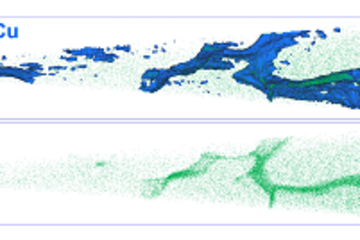All genres
801.
Journal Article
The exoskeleton of the lobster Homarus americanus as an example of a smart anisotropic biological material. Acta Biomaterialia 3 (3), pp. 301 - 309 (2007)
802.
Journal Article
The influence of sterilization processes on the micromechanical properties of carbon fiber reinforced PEEK composites for bone-implant applications. Acta Biomaterialia 3 (2), pp. 209 - 220 (2007)
803.
Journal Article
Design of high-strength steels by microalloying and thermomechanical treatment. Special Issue Materials Science and Engineering A 463, pp. 138 - 146 (2007)
804.
Journal Article
Orientation microscopy on nanostructured electrodeposited NiCo-Films. Advanced Materials Research 15-17, pp. 953 - 958 (2007)
805.
Journal Article
Retention of the Goss orientation between microbands during cold rolling of an Fe3%Si single crystal. Acta Materialia 55, pp. 2519 - 2530 (2007)
806.
Journal Article
A Finite Element approach with patch projection for strain gradient plasticity formulations. International Journal of Plasticity 23, pp. 690 - 710 (2007)
807.
Journal Article
Relative Importance of Nucleation vs. Growth for Recrystallisation in Particle-containing Fe3Al Alloys. Materials Science Forum 550, not specified, pp. 345 - 350 (2007)
808.
Journal Article
The small-angle and wide-angle X-ray scattering set-up at beamline BL9 of DELTA. Journal of Syncroton Radiation 14, pp. 244 - 251 (2007)
809.
Journal Article
A dislocation density based constitutive law for BCC materials in crystal plasticity FEM. Computational Materials Science 39, pp. 91 - 95 (2007)
810.
Journal Article
A texture-component Avrami model for predicting recrystallization textures, kinetics and grain size. Modelling and Simulation in Materials Science and Engineering 15, pp. 39 - 63 (2007)
811.
Journal Article
Recrystallization Models for the Prediction of Crystallographic Textures with Respect to Process Simulation. The Journal of Strain Analysis for Engineering Design 42 (4), pp. 253 - 268 (2007)
812.
Journal Article
Preferred crystallographic texture of α-chitin as a microscopic and macroscopic design principle of the exoskeleton of the lobster Homarus americanus. Acta Biomaterialia 3, pp. 882 - 895 (2007)
813.
Journal Article
Mechanism Oriented Steel Development. Steel Research International 78, pp. 195 - 198 (2007)
814.
Journal Article
Equal channel angular extrusion of niobium single crystals. Materials Science and Engineering: A 467, pp. 44 - 52 (2007)
815.
Journal Article
Investigation of orientation gradients in pearlite in hypoeutectoid steel by use of orientation imaging microscopy. Steel Research International 78 (1), pp. 38 - 44 (2007)
816.
Journal Article
Simulation of earing during deep drawing of an Al-3%Mg alloy (AA 5754) using a texture component crystal plasticity FEM. Journal of Materials Processing Technology 183, pp. 169 - 175 (2007)
817.
Journal Article
Roughness-induced flow instability: A Lattice Boltzmann study. Journal of Fluid Mechanics 573, pp. 191 - 209 (2007)
818.
Journal Article
Chaotic flows in microchannels: A lattice Boltzmann study. Molecular Simulation 33 (7), pp. 583 - 587 (2007)
819.
Journal Article
A texture component model for predicting recrystallization textures. Materials Science Forum 558 / 559, pp. 1035 - 1042 (2007)
820.
Journal Article
Modeling and experiments on the indentation deformation and recrystallization of a single‑crystal nickel-base superalloy. Materials Science and Engineering A 454–455, pp. 433 - 440 (2007)











